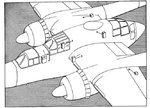Hello,
This time, you run the design phase of the next-gen heavy bomber. The plane should be in production by Jan 1943, and it must be able to receive the upgrades, in order to stay competitive in 1944. The gun armament (if fitted*), engines electronics are the ones historically available (= production being in good numbers) for the air force of your choosing, the plane featuring 4 engines. The thread acknowledges that production priorities were shifting in some belligerent nations, but that has no influence on the thread - your bomber need to be as good as possible within the time frame. The design should start from a clean sheet of paper, thank you
*you can design both armed non-armed planes, both for day night duties
This time, you run the design phase of the next-gen heavy bomber. The plane should be in production by Jan 1943, and it must be able to receive the upgrades, in order to stay competitive in 1944. The gun armament (if fitted*), engines electronics are the ones historically available (= production being in good numbers) for the air force of your choosing, the plane featuring 4 engines. The thread acknowledges that production priorities were shifting in some belligerent nations, but that has no influence on the thread - your bomber need to be as good as possible within the time frame. The design should start from a clean sheet of paper, thank you
*you can design both armed non-armed planes, both for day night duties

